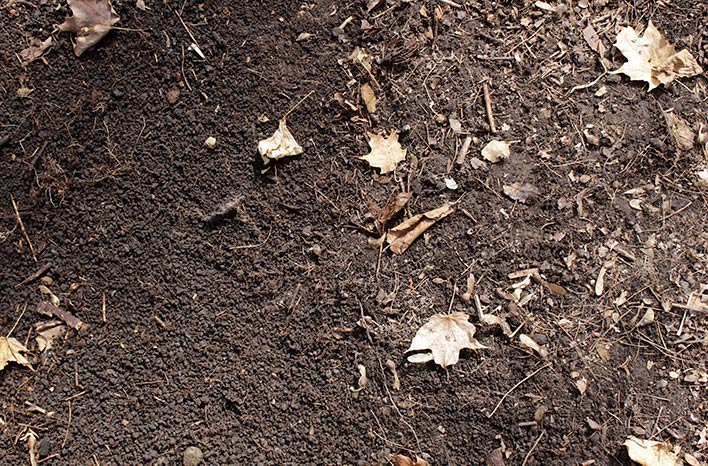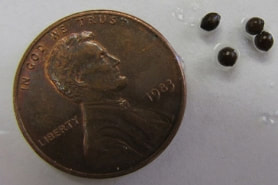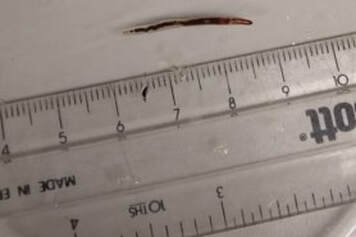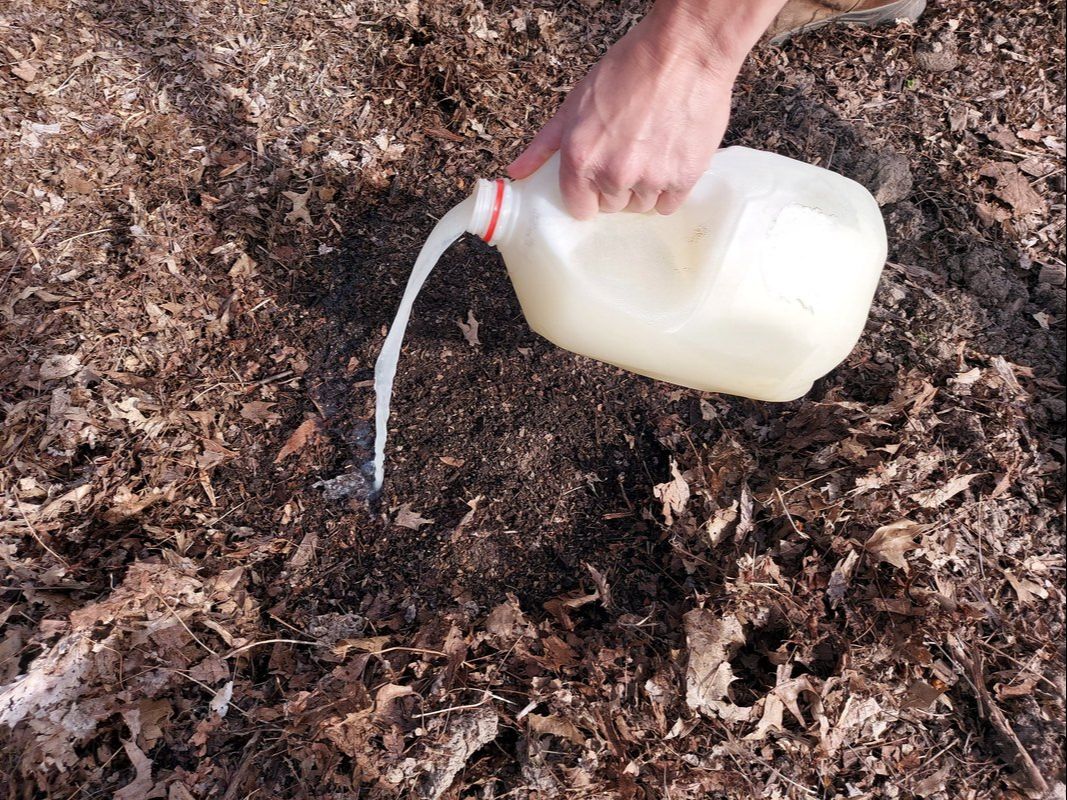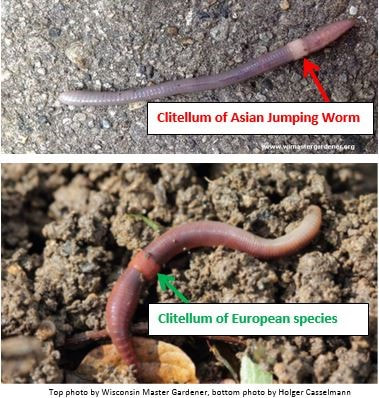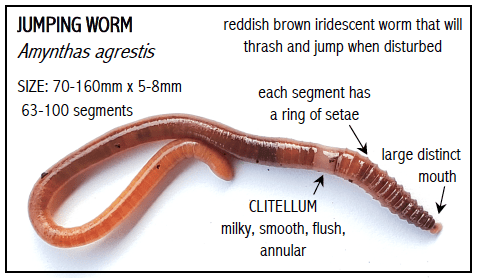Jumping Worms
|
Jumping worms are an invasive species from Asia and have been reported in gardens in Bloomington. They are very difficult to eradicate once established, so preventing their movement and introduction through the movement of soil, plants, and mulch is very important.
There are different species of jumping worms, but they are all in the Amynthas genus and have similar characteristics and behavior. They get their common name from their dramatic thrashing when disturbed as shown in the videos to the right. Click the brochure cover below to read our publication on jumping worms. |
This thrashing behavior when disturbed is characteristic of jumping worms (Video above from Wisconsin Department of Natural Resources, below from Dottie Warmbier)
|
|
The boundary of an area invaded by jumping worms, with the jumping worms' granular castings on the left and uninvaded soil on the right.(Photo by Susan Day, UW - Madison Arboretum)
|
Why Are Jumping Worms a Problem?
Jumping worms feed on organic matter and break it down very rapidly, consuming nutrients that plants and soil biota need to survive. Unlike other worm species, jumping worms stay close to the soil surface and so aren't effective at aerating the soil. They produce castings that resemble large coffee grounds (shown in photo at left), which provide few nutrients and poor structure for native plants. When native plants start to decline, an increase in invasive plants may be seen.
|
How Can I Tell If I Have Jumping Worms?
|
Jumping worms live only one season, and while jumping worms hatch from cocoon-encased eggs in April, they are very small and hard to see at this stage and the clitellum may not be visible.They grow through the summer months, maturing by August. They should be active and identifiable by late May. There are two ways you can look for jumping worms.
1. Mustard Water Test Supplies needed:
Mix 1/3 cup ground mustard in one gallon of water. Clear leaf litter and debris from the surface of one square foot area. If it is very dry, you can water the area first so the mustard water is most effective. Slowly pour half of the mustard solution over the soil. Within a minute or two, if present, earthworms will begin to appear within a minute, forced to the surface because the mustard irritates their skin. Be ready to immediately collect worms (having an extra set of hands is helpful at this point) and put them in a bucket. After collecting worms, pour the rest of the mustard water over the area and watch for any more to emerge. 2. Bait Area Find a bare area in your yard that is shady and generally moist. Cover the area with 3-4" of leaf or wood mulch and water it to keep the soil moist. This will attract jumping worms to the bait area. To check for worms, use a rake to gently pull back the mulch layer and watch for worms at the soil surface. Once you have found worms, look for these features:
|
Jumping worm cocoons (Photo by Marie Johnston, UW - Madison Arboretum)
Newly hatched jumping worm (Photo by Marie Johnston, UW - Madison Arboretum)
Pouring mustard solution over cleared ground
|
Elements to look for when trying to identify jumping worms (Photo by Linda Tucker Serniak, Oregon State University, and Joanne Schneidermann Dole, Master Gardener).
What Do I Do If I Find Jumping Worms?
- If you find jumping worms, PLEASE REPORT THEM! You can report them at EDDMaps.org either through the app or on a computer by choosing 'jumping worm (Amynthas sp.)' from the drop down menu. More detail provided below under More Frequently Asked Questions.
- Take precautions to avoid spreading them. Do not share plants, soil, or compost from infested areas with other gardeners.
- Remove and destroy jumping worms when you see them. One way to kill them is to put them in a plastic bag and leaving them in the sun for 10 minutes; another is to drop the worm into a container with 1" of household vinegar in the bottom.
- For more information on jumping worms and possible control methods, visit this Wisconsin DNR website.
More Frequently Asked Questions
Can I use hot dog mustard instead of ground mustard to bring up worms? No, the concentration of mustard in yellow or brown liquid mustard is not high enough to bring up worms, and includes vinegar, salt, and other components that aren’t good for soil health.
How many eggs can a jumping worm lay in a year? It is not currently known how many eggs each adult can lay in the wild, however in laboratory settings, up to 30 cocoons with 2 eggs each have been observed.
How do we report the results of our test? Whether your test results are negative or positive, please report them! Go to EDDMaps.org and set up a profile if you don’t already have one. Then -
Will the mustard hurt my plants? Mustard is not toxic to plants and does not accumulate in tissue.
Do birds eat these worms like others? They try and some do– but the energetic thrashing can allow jumping worms to escape, and they also drop their tails when attacked, confusing the bird and sometimes escaping that way. Video of this happening - https://youtu.be/HzuQjVZTCYE
So, it's ok to share plants as long as you don't share dirt? Yes – if there is absolutely no soil on the roots, down to 1 mm particles in size (which is the size of the eggs).
How many eggs can a jumping worm lay in a year? It is not currently known how many eggs each adult can lay in the wild, however in laboratory settings, up to 30 cocoons with 2 eggs each have been observed.
How do we report the results of our test? Whether your test results are negative or positive, please report them! Go to EDDMaps.org and set up a profile if you don’t already have one. Then -
- Choose ‘Report Sightings’ from choices along top of website
- Choose ‘Wildlife’ for ‘What are you reporting?’
- Choose ‘Indiana’ for ‘Where?’
- The report form comes up.
- At the very top, choose ‘negative’ if you found no jumping worms, ‘positive’ if you did find jumping worms
- Under ‘Species’ enter ‘jumping worm’ in box (NOTE – NO ‘S’ on the end). Choose ‘jumping worm (Amynthas spp.)’.
- Fill in date, state, county and put a dot on the map for your location. You can enter any of the other fields you want, but it’s not required.
- Attach at least one photo if you have a positive finding.
- Choose ‘Submit Report’
Will the mustard hurt my plants? Mustard is not toxic to plants and does not accumulate in tissue.
Do birds eat these worms like others? They try and some do– but the energetic thrashing can allow jumping worms to escape, and they also drop their tails when attacked, confusing the bird and sometimes escaping that way. Video of this happening - https://youtu.be/HzuQjVZTCYE
So, it's ok to share plants as long as you don't share dirt? Yes – if there is absolutely no soil on the roots, down to 1 mm particles in size (which is the size of the eggs).

